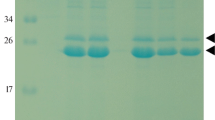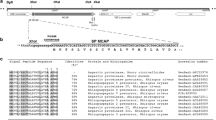Abstract
Pseudoenzymes are homologs of active enzymes that have amino acid substitutions in the active center and, therefore, usually do not possess enzymatic activity. In this work, a recombinant proprotein (proSerPH122) of the homolog of serine peptidases of the S1 family from the yellow mealworm (Tenebrio molitor) was obtained in the yeast producer strain Komagataella kurtzmanii. The target His6-tagged protein was produced in a glycosylated form during secretion in yeast. The properties of both glycosylated and deglycosylated forms were studied. The proSerPH122 homolog with the replacement of active site Ser with Thr was pretreated with trypsin to study the enzymatic properties. The processed, mature homolog SerPH122 was shown to have low, but reliably detectable activity on the chromogenic substrate Suc-Ala-Ala-Pro-Phe-pNA, and this activity did not depend on the glycosylation level.






Similar content being viewed by others
REFERENCES
Rawlings, N.D., Barrett, A.J., Thomas, P.D., Huang, X., Bateman, A., and Finn, R.D., Nucleic Acids Res., 2018, vol. 46, no. D1, pp. D624–D632. https://doi.org/10.1093/nar/gkx1134
Brown, J.R. and Hartley, B.S., Biochem. J., 1966, vol. 101, no. 1, pp. 214–228. https://doi.org/10.1042/bj1010214
Perona, J.J., Hedstrom, L., Rutter, W.J., and Fletterick, R.J., Biochemistry, 1995, vol. 34, no. 5, pp. 1489–1499. https://doi.org/10.1021/bi00005a004
Perona, J.J. and Craik, C.S., Protein Sci., 1995, vol. 4, no. 3, pp. 337–360. https://doi.org/10.1002/pro.5560040301
Wex, T., Lipyansky, A., Bromme, N.C., Wex, H., Guan, X.Q., and Bromme, D., Biochemistry, 2001, vol. 40, no. 5, pp. 1350–1357. https://doi.org/10.1021/bi0022660
Wu, C.Y., Huang, J.M., Zhao, Y.J., Xu, Z.W., and Zhu, J.Y., Toxicon, 2020, vol. 183, pp. 29–35. https://doi.org/10.1016/j.toxicon.2020.05.011
Pils, B. and Schultz, J., J. Mol. Biol., 2004, vol. 340, no. 3, pp. 399–404. https://doi.org/10.1016/j.jmb.2004.04.063
Yang, L., Lin, Z., Fang, Q., Wang, J., Yan, Z., Zou, Z., Song, Q., and Ye, G., Dev. Comp. Immunol., 2017, vol. 77, pp. 56–68. https://doi.org/10.1016/j.dci.2017.07.014
Reynolds, S.L. and Fischer, K., Biochem. J., 2015, vol. 468, no. 1, pp. 17–24. https://doi.org/10.1042/BJ20141506
Bryant, B., Ungerer, M.C., Liu, Q., Waterhouse, R.M., and Clem, R.J., Insect Biochem. Mol. Biol., 2010, vol. 40, no. 7, pp. 516–523. https://doi.org/10.1016/j.ibmb.2010.04.011
Martynov, A.G., Elpidina, E.N., Perkin, L., and Oppert, B., BMC Genomics, 2015, vol. 16, no. 75. https://doi.org/10.1186/s12864-015-1306-x
Naumov, G.I., Naumova, E.S., Tyurin, O.V., and Kozlov, D.G., Antonie van Leeuwenhoek, 2013, vol. 104, no. 3, pp. 339–347. https://doi.org/10.1007/s10482-013-9956-7
Gorbunov, A.A., Akent’ev, F.I., Gubaidullin, I.I., Zhiganov, N.I., Tereshchenkova, V.F., Elpidina, E.N., and Kozlov, D.G., Biotekhnologiya, 2020, vol. 36, no. 6, pp. 78–86. https://doi.org/10.21519/0234-2758-2020-36-6-78-86
Matveeva, A.Yu., Gubaidullin, I.I., Fedorov, A.S., and Kozlov, D.G., Biotekhnologiya, 2019, vol. 35, no. 5, pp. 3–11. https://doi.org/10.21519/0234-2758-2019-35-5-3-11
Kozlov, D.G. and Yagudin, T.A., Biotechnol. Lett., 2008, vol. 30, no. 9, pp. 1661–1663. https://doi.org/10.1007/s10529-008-9739-9
Sievers, F., Wilm, A., Dineen, D., Gibson, T.J., Karplus, K., Li, W., Lopez, R., McWilliam, H., Remmert, M., Soding, J., Thompson, J.D., and Higgins, D.G., Mol. Syst. Biol., 2011, vol. 7, p. 539. https://doi.org/10.1038/msb.2011.75
Nicholas, K.B., Nicholas, H.B.Jr., and Deerfield, D.W., Embnew. News, 1997, vol. 4, p. 14. http://www.psc.edu/biomed/genedoc
Armenteros, J.J., Tsirigos, K.D., Sonderby, C.K., Petersen, T.N., Winther, O., Brunak, S., von Heijne, G., and Nielsen, H., Nat. Biotechnol., 2019, vol. 37, no. 4, pp. 420–423. https://doi.org/10.1038/s41587-019-0036-z
Tereshchenkova, V.F., Klyachko, E.V., Benevolenskii, S.V., Belozerskii, M.A., Dunaevskii, Ya.E., Filippova, I.Yu., and Elpidina, E.N., Appl. Biochem. Microbiol., 2019, vol. 55, no. 3, pp. 218–223.
Frugoni, J.A.C., Gazz. Chem. Ital., 1957, vol. 87, pp. 403–407.
Parry, M.A., Fernandez-Catalan, C., Bergner, A., Huber, R., Hopfner, K.P., Schlott, B., Guhrs, K.H., and Bode, W., Nat. Struct. Biol., 1998, vol. 5, no. 10, pp. 917–923. https://doi.org/10.1038/2359
Hedstrom, L., Chem. Rev., 2002, vol. 102, no. 12, pp. 4501–4524. https://doi.org/10.1021/cr000033x
Vinokurov, K.S., Elpidina, E.N., Oppert, B., Prabhakar, S., Zhuzhikov, D.P., Dunaevsky, Y.E., and Belozersky, M.A., Comp. Biochem. Physiol. B. Biochem. Mol. Biol., 2006, vol. 145, no. 2, pp. 126–137. https://doi.org/10.1016/j.cbpb.2006.05.005
ACKNOWLEDGMENTS
The authors are grateful to M.V. Serebryakova for the mass-spectrometric analysis of the preparation of the recombinant prohomolog proSerPH122.
Funding
The study was carried out with the financial support of a grant from the Russian Science Foundation (project no. 19-74-00080).
Author information
Authors and Affiliations
Corresponding author
Ethics declarations
The authors declare that they have no conflict of interest. This article does not contain any studies involving animals or human participants performed by any of the authors.
Rights and permissions
About this article
Cite this article
Tereshchenkova, V.F., Zhiganov, N.I., Akentyev, P.I. et al. Preparation and Properties of the Recombinant Tenebrio molitor SerPH122—Proteolytically Active Homolog of Serine Peptidase. Appl Biochem Microbiol 57, 579–585 (2021). https://doi.org/10.1134/S0003683821050161
Received:
Revised:
Accepted:
Published:
Issue Date:
DOI: https://doi.org/10.1134/S0003683821050161




